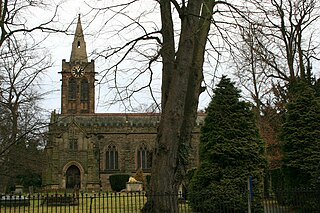
Royal Ordnance Factory (ROF) Bridgwater was a factory between the villages of Puriton and Woolavington in the Sedgemoor district of Somerset, UK that produced high explosives for munitions. It was slightly above sea level, between the 5 and 10 metre contour lines on Ordnance Survey maps. BAE Systems closed it when decommissioning was completed in July 2008.

West Bridgford is a town and the administrative centre of the Borough of Rushcliffe in the county of Nottinghamshire, England. It lies immediately south of Nottingham, east of Wilford, north of Ruddington and west of Radcliffe-on-Trent. It is southwest of Colwick and southeast of Beeston which are on the opposite bank of the River Trent. The town is part of the Nottingham Urban Area and had a population of 48,225 in a 2018-estimate.

Ruddington is a large village in the Borough of Rushcliffe in Nottinghamshire, England. The village is 5 miles (8 km) south of Nottingham and 11 miles (18 km) northwest of Loughborough. It had a population of 6,441 at the 2001 Census, increasing to 7,216 at the 2011 Census.
ROF Bridgend,, located in Bridgend, South Wales, was one of the largest of sixteen World War II, UK government-owned, Royal Ordnance Factory munitions Filling Factories. Of great significance to the Britain's war effort, at its peak of production it employed around 40,000 people — said to be the largest ever factory in Britain's history.
Royal Ordnance Factories (ROFs) was the collective name of the UK government's munitions factories during and after the Second World War. Until privatisation, in 1987, they were the responsibility of the Ministry of Supply, and later the Ministry of Defence.
A filling factory was a manufacturing plant that specialised in filling various munitions, such as bombs, shells, cartridges, pyrotechnics, and screening smokes. In the United Kingdom, during both world wars of the 20th century, the majority of the employees were women.
Royal Ordnance Factory (ROF) Elstow was one of sixteen UK Ministry of Supply, World War II, Filling Factories. It was a medium-sized filling factory,, which filled and packed munitions. It was located south of the town of Bedford, between the villages of Elstow and Wilstead in Bedfordshire. It was bounded on the northeast by the A6 and on the west by a railway line. Hostels were built nearby to accommodate the workers who were mostly female.

The Royal Ordnance Factory was a WW2 Ministry of Supply Explosive Factory. It is sited adjacent to the village of Bishopton in Renfrewshire, Scotland. The factory was built to manufacture the propellant cordite for the British Army and the Royal Air Force. It also later produced cordite for the Royal Navy. The Ministry of Works were responsible for the site. It was the biggest munitions factory the MOD had, with up to 20,000 workers.
RAF Credenhill, also known as RAF Hereford, was a non-flying station of the Royal Air Force situated in the village of Credenhill near Hereford, England, United Kingdom. It was commissioned in 1940 and served as home for a range of training schools from 1940 until closure in 1994. The site was subsequently obtained by the British Army.
Royal Ordnance Factory (ROF) Nottingham opened in 1936 in The Meadows, Nottingham, United Kingdom. It was one of a number of Royal Ordnance Factories created in the build up to World War II. During the war the site employed up to four thousand workers. The factory was closed in 2001.

Rushcliffe Country Park is an open park space covering approximately 210 acres (0.85 km2), located on Mere Way just south of Ruddington on the A60 in the borough of Rushcliffe, Nottinghamshire, England. The park has maintained the Green Flag award for twelve years; the national standard for parks and green spaces in England and Wales.
ROF Kirkby, was a large World War II Royal Ordnance Factory (ROF) filling munitions. The factory was based in the rural area of Kirkby, on the outskirts of Liverpool, Merseyside. The rural location was to reduce the potential damage from any accidental explosions. Munitions were produced from September 1940 to March 1946.
ROF Risley, was a large World War II Royal Ordnance Factory filling munitions, including the Grand Slam bomb, in the UK. It is located roughly halfway between Liverpool and Manchester.
The Nottingham Heritage Railway (formerly known as Great Central Railway is a heritage railway and transport museum on the south side of the village of Ruddington in Nottinghamshire. The route consists of almost 10 miles of the former Great Central Railway Main Line from Loughborough South Junction to Fifty Steps Bridge and the site of Ruddington's former GCR station, plus a branch line from Fifty Steps Bridge to Ruddington Fields station which is located on a former Ministry of Defence site next to Rushcliffe Country Park.
ROF Rotherwas was a Royal Ordnance Factory filling factory, No 4, located in Rotherwas, Dinedor Parish, Herefordshire, England.
National Filling Factory, Banbury, officially called National Filling Factory No. 9. was a British Ministry of Munitions filling factory, constructed during World War I and located in Banbury, Oxfordshire. The production of filled shells began in April 1916 and ended when the factory closed in 1924

MoD Bicester is a large military storage and distribution centre just outside Bicester in Oxfordshire.








